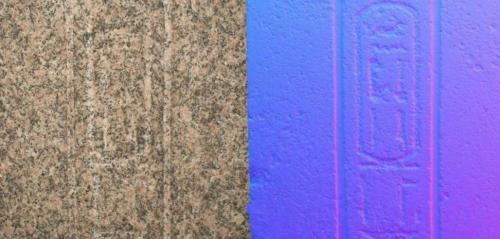Oxford University
Source - http://phys.org/news/2014-11-oxford-team-ancient-egyptian-obelisk.html

History was made this month as the robotic Philae lander completed the first controlled touchdown on a comet. The European Space Agency-led project was set up to obtain images of a comet's surface and help scientists to understand what a comet is made of.
The lander and the Rosetta probe which transported it were named after two of the objects which were crucial in deciphering Egyptian hieroglyphs: the Rosetta stone and the Philae obelisk. Back on earth, a team from the Centre for the Study of Ancient Documents in Oxford's Classics Faculty are using a powerful digital imaging system, Reflectance Transformation Imaging (RTI), to study the inscriptions on the obelisk more closely than ever before.
'The Centre is home to an exciting new study of Ptolemaic inscriptions (a Hellenistic kingdom based in Egypt in the fourth to first centuries BC) and the Philae obelisk and Rosetta stone are the jewels of the crown of that corpus,' said Dr Jane Masséglia of the Centre for the Study of Ancient Documents (CSAD). Both include inscriptions in Egyptian hieroglyphs and ancient Greek, but while the Rosetta stone's inscriptions are direct translations of one another, the inscriptions on the obelisk are different.
'Both ancient Greek and Egyptian scripts on the obelisk mention the names 'Ptolemy' and 'Cleopatra' which helped nineteenth-century scholars to use their knowledge of ancient Greek to translate some of the Egyptian hieroglyphs.'
The obelisk is one of two found at Philae in Upper Egypt in 1815. It was acquired by William John Bankes, who brought it to his estate at Kingston Lacy in Dorset, now owned by the National Trust.
'After 200 years being battered by the English weather in Dorset, and because of the naturally speckled pink and black granite, it's difficult for the human eye to read all of the inscriptions,' said Dr Masséglia.
'RTI has let us take images of the obelisk in such a way that can remove the colour. It produces a computer reconstruction of the surface of the object, based on reflections of light, so we have been able to produce clearer images of the inscriptions than ever before.'
The Oxford team is currently analysing the images taken from the obelisk but they have already made some findings about the inscriptions. 'We have an early nineteenth-century drawing of the obelisk, made just before it was announced that hieroglyphs had been deciphered,' said Dr Masséglia. 'Now that we have the high-quality RTI images, we can say that whoever produced that drawing really knew what they were doing. It's a very good record for such an early date and may even be the very document that was sent by Bankes to Champollion, the man credited with the eventual decipherment of hieroglyphs.
'Our next project is to complete the reading of the ancient Greek inscription on the base, which has never been entirely legible, not even when Bankes first saw it in Philae. We can see that it records a petition from the priests of Philae to Ptolemy VIII and his two wives, asking to be exempted from tax. But large sections of the text are badly worn, and RTI is the technology to help us complete the picture. It's very exciting.'
CSAD hosts several research projects that are using RTI to investigate important areas of classical scholarship. Projects include studying Roman letters from Vindolanda near Hadrian's Wall, ancient curse tablets from Roman Gloucestershire, and a new study of the Latin inscriptions in the Ashmolean Museum.
'The technology is so exciting because we can apply it to so many different ancient artefacts which cannot be fully understood by the human eye,' said Dr Masséglia. 'Our RTI expert, Ben Altshuler, has also been working with colleagues in the Beazley archive to study microscopic marks on ancient gems and even Greek vases.
'It's so good, it can even show which line was painted over which, and see the marks of preparatory drawings underneath the glaze. You can imagine what a difference this could make to someone's experience of archaeology. Whether at the museum or sitting at home, they could use the RTI software to examine an object in minute detail, and see more than they ever could with the naked eye.'